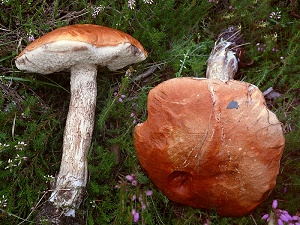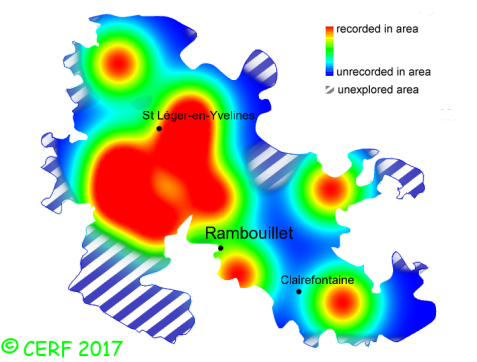| Leccinum aurantiacum (Bull.) Gray |
|
|
|
|
|
|
The cap is of a uniform colour, red-orange to orange-brown (redder when very young), peelable, fleshy, firm, of globular shape at the beginning, then hemispherical, convex and finally flat-convex. The cap's diameter is hardly higher than the stem's length on young specimens.. The cap surface is dry, smooth to very finely downy. The cap margin is exceeding (up to 3mm), potentially covering pores, particularly in young specimens. The stem is full, long and firm-tough, rough because of the small whitish scales covering it, these becoming orange like the cap, then brown with age. It is more or less equal in diameter or with a slightly swollen base. This base is often stained with blue-green, especially when pressed. The stem's surface background colour is white, under the coloured scales.. The flesh is thick, firm, getting soft when ageing in the cap, the stem being fibrous. It is white but becomes fleetingly pink when in contact with air, then uniformly purple grey, and finally blackish grey (the stem base becoming itself sometimes green-blue when exposed to air); its taste is faint or mild; the odour is weak to pleasant; The tubes are practically free, or adnate through a groove, thin, long (10-40mm). They are white then yellowish-grey, turning pink when cut and exposed to air. The pores are very small, round, white or cream then greyish, and eventually yellow grey, turning red when pressed. The spore print is pale brown. It grows in grassy areas (clearings or wood edges) of damp deciduous forests; sometimes with conifers (mountains) or heather, or in parks, on a rather acid, but also calcareous soil, essentially with aspen, but also hornbeam, birch, alder, oak, beech, spruce or fir. The fruiting period takes place from May to December.
Chemical tests : no reaction of flesh to ammonia. Distinctive features : orange cap; grey to white pores; tough stem, covered with small white (then dark rusty when mature) scales; flesh turning pink then black when exposed to air; primarily with aspen Leccinum aurantiacum is infrequent and scattered in the forest of Rambouillet, and is occasional, more generally speaking . | ||
|
page updated on 14/01/18

